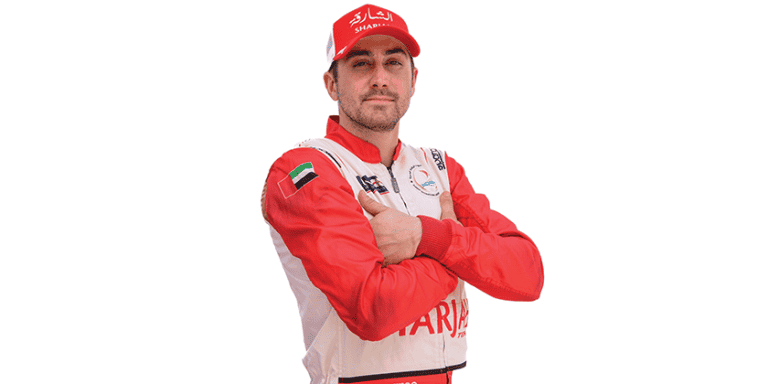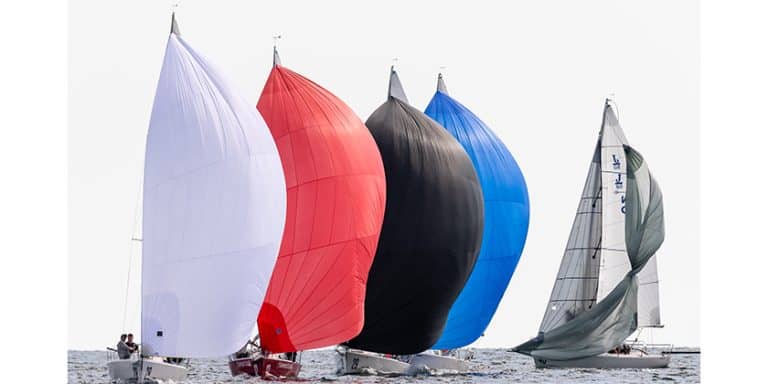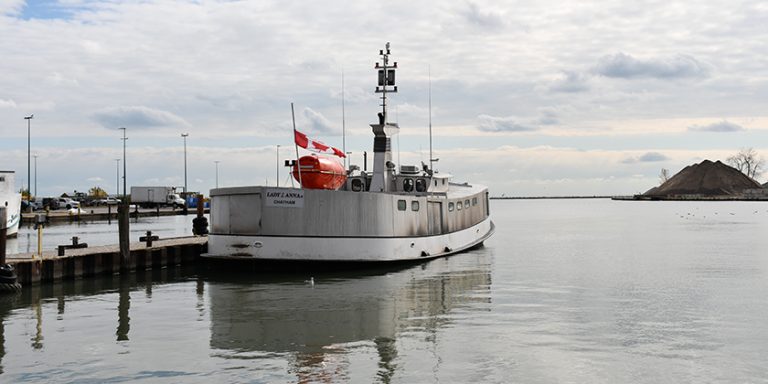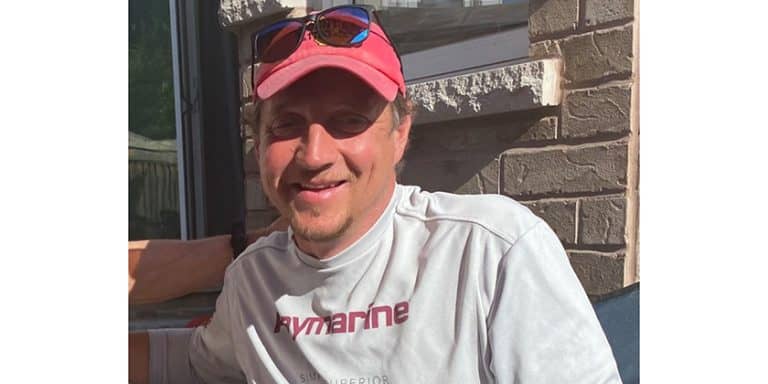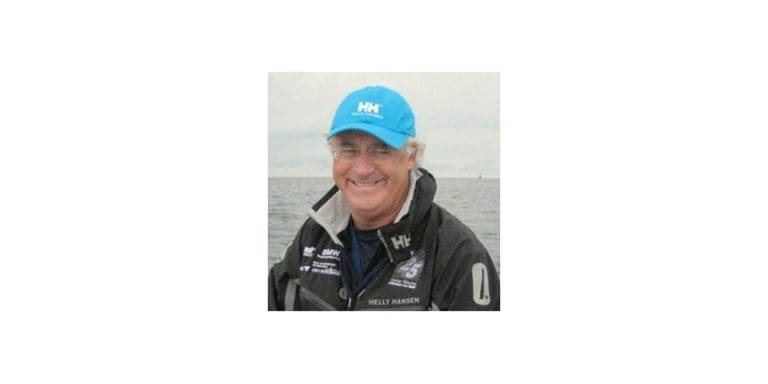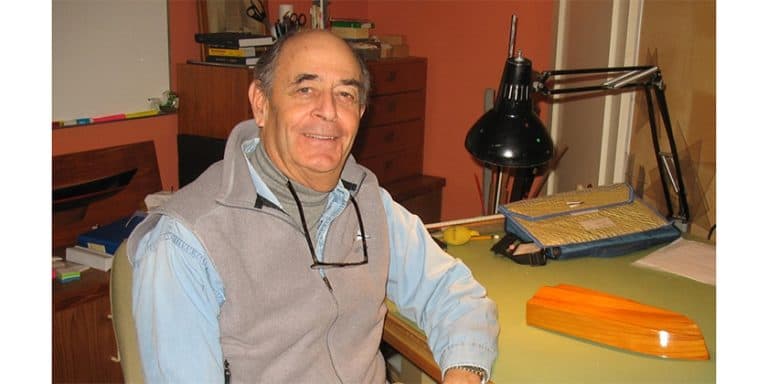A Prairie Boys Voyage
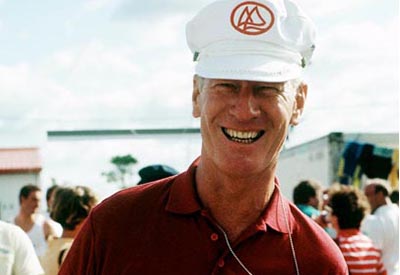
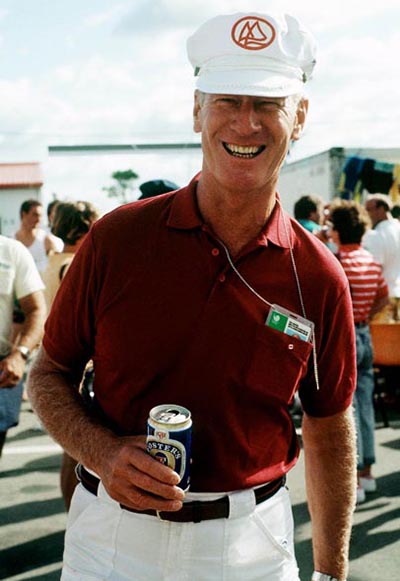
In this full version of the Dennis Toews story which is extended from the snippet in Canadian Yachting’s May 2015 issue, we’re sure you will enjoy reading about the recollections of an amazing life and Dennis’ experiences with the stars of competitive sailing. Have you sailed with, or against Dennis? Perhaps you have a Dennis Toews story, or picture you want to share. Canadian Yachting welcomes reader feedback anytime.
By Dennis Toews
My early reading about sailing explorers and fur trading voyageurs gave me a desire to travel by water. As a boy growing up in Gladstone, Manitoba, I constructed a rather poorly built raft.
I planned to journey down the Whitemud River to Lake Manitoba. I managed to get a half a mile downstream before my raft disintegrated and plunged me into the river. I emerged cold and wet but determined to do better in my water-borne travels.
Our family cottage was at Delta Beach at the south end of Lake Manitoba. A neighbour had an old wooden “Lightning” anchored in three feet of water. My younger brother Bryan and I would climb into it and pretended we sailed the seven seas, even though the boat never moved, other than up and down with the waves.
In my early teen’s we lived on the shore of Lake Killarney in Southern Manitoba. Bryan and I had a canoe. We would paddle upwind, then hang an old bed-sheet between the paddles and sail downwind.
In Hamilton, Ontario in the mid 50’s I rowed at the Leander Boat Club. Our races took place in Hamilton, Toronto, London, St. Catherines, Buffalo N.Y. and Philadelphia, Penn. We frequently raced against John B. (Jack) Kelly Jr. The brother of Grace Kelly of movie fame. In the Olympic Trials leading up to Melbourne in 1956 we lost to UBC, Vancouver Rowing Club. They won a Gold Medal in Melbourne.
In a Hamilton coffee shop I met Bob Marshall. I would tell him about my rowing competitions. He told me about his sailing experiences. He said that he had a six meter sailboat designed by Sparkman & Stephens for the 1936 Olympics. He invited me to sail with him starting in the summer of 1959.
The first day I stepped aboard the boat was at the Burlington Yacht Club for a club race. There was the bang of the starting gun followed two seconds later by the bang of the wooden mast breaking at the lower spreaders and crashing over the side. My introduction to sailboat racing could not have been less promising.
Bob said he could use another crew so I invited my good friend Ron Ormiston to join us. Bob moved the boat to Metro Marine in Bronte.”Firecracker” got a new aluminum mast. That 1959 summer was the start of my involvement in sailboat racing. I use the term advisedly because we competed at clubs around Lake Ontario. Our starts went reasonably well but ultimately we managed to consolidate our position by protecting the fleet from attacks from the rear. Bob was very democratic and had us operate at every position on the boat including helming.
Tony Ronza Sr. had a C&C 51 Ft. yawl “Galatea” in Bronte that he raced. Ron and I crewed for him. We had a modest degree of success in the long distance races. It was during this time that a group gathered with the object of forming a yacht club. Harry Greb of “Greb Industries” assisted those interested, but he required that the club would have a sailing school. Their efforts came to fruition as the” Bronte Harbour Yacht Club,” founded in1962.
For the 1960 sailing season Ron and I felt our sailing skills could be honed more quickly by sailing smaller boats. Don Barnes had just moved from Ottawa, he introduced us to Dave Kirby, the older brother of Bruce who would later design the “Laser”. We purchased Dave’s used International 14 dinghy. It was a “54 Bourke” painted black. Ron and I over the winter restored the original varnished finish. We were equal partners and the question was who would helm. Ron suggested we toss a coin. My reply to Ron was, ”you are a Civil Engineer and understand levers, I am taller and heavier than you, therefore I will crew”.
Don Barnes was the spark plug that ignited the 14 fleet at Royal Hamilton Yacht Club. I think we were the fourth boat in the fleet. Within a couple of years the fleet numbered eighteen.
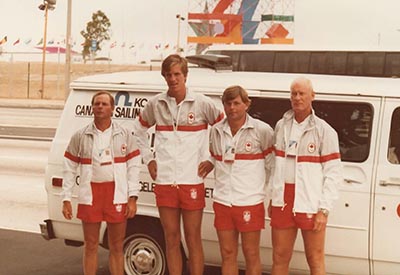 In the following summers we had the opportunity to meet and compete against sailors like: Bruce Kirby, Ian Bruce, Paul Henderson, Paul McLaughlin, Bill Gooderham, Stuart Walker, George O’Day, Harry Jemmett, Ward McKim and so many more great International 14 sailors.
In the following summers we had the opportunity to meet and compete against sailors like: Bruce Kirby, Ian Bruce, Paul Henderson, Paul McLaughlin, Bill Gooderham, Stuart Walker, George O’Day, Harry Jemmett, Ward McKim and so many more great International 14 sailors.
One year at the “Buzzard’s Bay Bowl” Ron and I started a race in wind speed over 25 MPH. The course was 18 miles long, three times around a triangle. On the reaches and the runs we were on a screaming plane, bouncing off the waves. We finished first, 11 minutes ahead of the next boat. On the committee boat at the end of the race the anemometer registered a wind speed of 52 MPH. What a ride!
In 1969 Don Barnes asked his 14 crew Doug Kilgour and I to join him in a campaign in the Soling. This boat would be in the 1972 Olympic Games in Kiel, Germany. Doug had graduated from “Queen’s” in Kingston. While there, he was an inter-collegiate boxing champion, known as “Killer Kilgour”.
We kept the Soling at RHYC and sailed club races. We also raced in Toronto, Rochester and Kingston. In our first “CORK” we finished 5th out of 70 plus boats. We spent time in Chicago. Here we raced against Bob Johnstone who with his brother would later found the company that built the “J-24” and the” J” line of boats. Bruce Goldsmith was 5 times “World Lightning Champion” and our sail maker at Murphy & Nye in Chicago. Bruce helped us with our sail knowledge. Judy Nye daughter of the owner was another very competitive sailor there. She was also Ted Turner’s first wife.
Our first big competition was the “Soling World’s” at the Seawanhaka Corinthian Yacht Club on Long Island Sound. It was light weather racing and we finished about a third of the way down a 70 boat fleet. I was fortunate to meet a sailor who became a friend. Robert “Bob” Mosbacher from Houston, Texas. Bob won the World Championship here at Seawanhaka. His brother “Buss” had won the first America’s Cup after the war. Bob would later become the United States Secretary of Commerce for President George Bush Sr.
To prepare for the Olympic Trials in Halifax in the spring of 1972 we kept the Soling in Annapolis, Maryland. We commuted there on week-ends during the winter of 1971/1972. We raced against the local fleet. Sam Merrick a Washington lawyer had a young crew member who had just graduated from university. He had an insatiable appetite to increase his sailing skills, over post-race beers I would answer his many questions, his name” Gary Jobson”. Whenever I get to see Gary I remind him (with my tongue planted firmly in my cheek) that I taught him well.
The Olympic Trials took place in Halifax in the spring of 1972, David Miller from Vancouver was overpowering, winning the trials with ease. We finished second. David with John Ekels and Paul Cote as crew won the Bronze medal at the Games in Kiel. (Paul Cote was one of the original three men who started “Greenpeace”.) Our skipper Don Barnes was the alternate helmsman on the Canadian Olympic Sailing Team at Kiel.
While the Olympics were on I was approached by Peter Nygard (Nygard International). He wanted to start a Star program for the 1980 Olympics with me crewing. I thanked him but declined.
Returning from Germany Don said he was giving up competitions. At this time Hans Fogh asked me to crew for him. I said to him, “Hans I like to win, but it has to be fun and enjoyable. I want to be the best crew I can be for you. However, you must win to sell sails. If in the future I do not meet your expectations replace me. In the same way if I am not enjoying myself I will leave. We will continue to be friends.” With this understanding of our respective goals Hans and I had a binding verbal contract.
John Dakin was our forward man. We won the first regatta of the 73 season on Biscayne Bay in Miami. Although John was and is an outstanding crew we all realized the Soling required more weight over the side, and so a search began for a bigger crew.
I remembered John Kerr at the Olympic Trials the previous year in Halifax. He had been crewing for Bill Abbott from Sarnia. John had just graduated from “Western” and through Abbott and John’s parents I was able eventually to track him down and get him on the phone at the university. I asked if he would join us. John agreed. John was strong, and the size we needed in the boat. He was much younger than Hans and I and his enthusiastic youthful attitude was a definite plus in the psychological make-up in the boat. Over the years that we sailed together it was a very happy boat. In 1984 at the Los Angeles Olympics John, Hans and Steve Calder won Bronze Medals.
At CORK in 1973 we won the Soling class. The helmsman receives the Rolex trophy and a Rolex watch. The crew as usual stands in the “wings” while the accolades are bestowed on the skipper.
After CORK Hans and Kirsten invited my wife Norma and I to a typical Danish dinner at their home. As dinner was finishing Hans said “Dennis you deserve the credit for our win more than I,” he handed me the watch that he had won, on the back was inscribed “To Dennis from Hans, CORK 1973”. The inscription has become worn and faded, but as I put the watch on every day the warm memory of a wonderful friend who is no longer with us re-kindles memories of joys mutually shared.
In the 70’s & 80’s in Canada we had a powerhouse of sailing talent in the Soling fleet. Glen Dexter from Halifax, Billy Abbott from Sarnia, Peter Hall from Montreal and Hans. At any competition most times one of the four would win and the rest would be in the top ten. This was in 70 and 80 boat fleets.
Hans had won the World FD Championships in 1975 with Evert Bastet as crew. Hans decided to try for the 76 Olympics in that Class. Paul Henderson had been sailing the FD & Finn dinghy, decided on a Soling program with John Kerr and I crewing. To prepare ourselves for the Trials, we spent a lot of time with “Buddy” Melges at his home in Wisconsin, practicing on Lake Geneva. Buddy in my opinion is the “complete” sailor. He is a boat builder, sail maker. Winner of World and Olympic Medals, winner of the America’s Cup. He is also helpful, humble, humorous, and great human being. I might add that his wife Gloria, “Mother Melges” has a tremendous positive influence on the man. One week we had the pleasure of sailing with and against Jim Hardy from Australia (as in Hardy Wines). It was late in the fall and snow was falling. We tested sails, we changed boats, we alternated crews to seek improved performance. We did not use hiking straps, rather hobbles around our ankles which we clipped onto a steel bar on the sole. After several changes we started upwind. I threw myself over the side, however I had neglected to “hook up”, the other crews gave me a 8.3 on style points as I performed a” backward one and a half “into the icy waters of Lake Geneva.
At the end of the 76 trials in Kingston there was a spread of 1.3 points between three boats in the penultimate race, Glen Dexter, Peter Hall and ourselves. The last race was abandoned for lack of wind. Glen won. I was named as an alternate crew to the 76 Canadian Olympic Sailing Team.
After 76 Paul purchased a Star Boat, and with Bruce Brymer crewing started a new chapter in his extensive sailing career. John and I returned to Hans in the Soling.
With Hans we competed in Canada, the United States, Norway, Germany and South America. At the World’s in 1978 in Rio de Janeiro, Brazil, we finished third. Gastao Brun of Brazil won, Glen Dexter from Halifax was second. He should have won. He needed to finish five boats in front of Gastao in the last race. Going up the last leg he was in that position, however a Brazilian sailor dropped out claiming equipment failure which gave Gastao the win. Glen was robbed. However he went on to win the Soling World Championship twice.
We had been sailing off Rio on long Atlantic rollers, 10 meters high and 300 meters crest to crest. As we surfed down the rollers the main would back and the spinnaker collapsed we were going so fast. Suddenly we crashed, it felt like we had struck bottom. As we started to sail again we saw a large splash behind us. The locals said that we had likely struck a ray. They are common thereabouts. They like to bask near the surface. They have wingspans of up to 30 feet and can weigh a ton. We had to get permission from the Jury to haul the boat. We had deep scratches caused by the barnacles on the ray. It took us three hours to repair the keel.
Our best year was 1978. We won CORK, the North American Championship and twelve other regattas. The ultimate was when back-to-back we won Kiel Week and then the European Championship in fleets of 80 plus boats.
It was during Kiel Week that we had a close battle with the legendary Paul Elvstrom. We managed to win. Afterwards I had no sense of elation with our victory. Instead I had a feeling of compassion for Paul. Time had taken its toll on this prodigious sailing talent.
In the winter of 1979 Robbie Haines an outstanding young sailor from San Diego asked Hans to come out to San Diego to sail test. I was opposed to it because in 1978 we had great speed and I felt we should not share it. Hans however felt this was an opportunity to try other sail maker’s products. Robbie had Rod Davis and Ed Trevelyan as crew.(they went on to careers in America’s Cup boats). Robbie had Hans stay at his home. John and I stayed in Coronado with Robbie’s father in law. In the evenings John and I were together and Hans was with Robbie. In hindsight I realized that Robbie saw Hans as the greatest threat to Robbie’s winning an Olympic medal in 1980. With their evenings together Robbie was able to convince Hans that he needed a tactician to lend greater strength to Hans’s 1980 Olympic program.
A few weeks later Hans asked an excellent Finn sailor, Sandy Riley to be his tactician, I would no longer be sailing with Hans. Steve Tupper our Olympic Coach said he would not allow it. He said our crew should stay intact because of our recent accomplishments. I told Steve I had a verbal contract with Hans that I would honour. Further I knew that Hans had to go down this path to see if it could improve his performance.
Peter Hall from Montreal heard I was available, he asked me to join him and Philip Kerrigan. I had sailed with Philip, Hans Fogh and john Kerr on the Canada’s Cup boat Marauder. Philip is a great sailor and a perfect shipmate. I told Peter he was a talented sailor but inclined to be too laid back. I said thanks but no thanks to his invitation. To Peter’s credit he said he had become much more serious and had retained a sports psychologist, Professor Wayne Haliwell the head of the Psychology Department at the University of Montreal to develop a program for him. Peter asked me to come to Montreal and meet Wayne.
I went to Montreal and was sold on the program he had developed for Peter. It was an extremely well constructed program. Diet, strength training, sail testing, boat preparation, weather studies, visualization, mental approach, and other disciplines.
Wayne had graduated with a Physical Education Degree from McMaster in Hamilton, Ontario. He then went to Europe to play professional hockey for six years. Then returning to pursue his higher education both in Canada and the United States.
In later years Wayne has worked with Olympic Gold Medalist skiers Jennifer Heil and Alexandre Bilodeau). When I was the leader of the 1988 and 1992 Olympic Sailing Team, Wayne was part of those teams. I was instrumental in having him be on the 1984 Team in Los Angeles.
With Peter, the first competition was in Kiel. Peter was sixth, Hans was 24th.This was the regatta that Hans, John and I had won the previous year. The next regatta was the World’s in Visby on Gotland in the Baltic. Peter Hall 5th, Hans Fogh 22nd.
While we were in Visby all the sailors, about 240, were asked to join in the “Gotland Games”. One of the events was tossing the caber. There were two sizes, one small and one large. The only sailor of the 240 of us that could handle the large caber was Andreas Josenhans from Halifax who was crew for Glen Dexter. Andreas was one of the strongest men I have ever known.
The first Olympic trial for 1980 was a windy CORK in Kingston which we won. The second trial the North American’s in Houston, Texas. Bill Abbot first, Hans second with Paul Davis as crew (the Sandy Riley experiment had ended). At the end of the regatta I said to Hans, “glad to see you back to doing it your way Hans, when you have as much confidence in yourself as I do, nobody is going to beat you”.
Our Trials finished at the Soling World’s in Ponce, Puerto Rico. Billy Abbott from Sarnia won the trials and Glen Dexter won the World’s.
Nobody went to the Olympics from Canada. The United States boycotted and sadly our Canadian politicians followed the USA. This deprived a generation of athletes of fulfilling their dreams. Dick Pound the I.O.C. member in Canada was furious. He rightly stated that sport should transcend politics. It irks me that our Government compared to many around the world, spends little on amateur sport. But when the Olympics are on the politicians are ever-present for their unearned photo-ops.
A personal observation: Peter Hall is a great sailor in all conditions. He has World Championship’s in the Soling and Lightning classes. It is my opinion that Peter and Sid Dakin are two of the best light weather sailors in the world. Interesting that they both started sailing on Lake St. Louis near Montreal.
During these times I crewed on two “Canada’s Cup” boats, Marauder and Coug. Sailing on Coug against Black Magic from the Bayview Yacht Club in Detroit we won the “Canada’s Cup”.
On Marauder we were competing on Lake St. Clair in the US Two-Ton Championship. The wind was blowing the dog off the chain. We were approaching the weather mark behind a Bruce King designed “Bilge Boarder”. We knew when they got on the reach and pulled up the boards they would be gone. After rounding they broached, we laughed. After we rounded we broached, Hans was chinning himself on the tiller and John Kerr was waist deep in water. We laughed later.
Sailing on” Nessie” an Elvstrom half-tonner we won the “Freeman Cup” by more than four hours on corrected time. Nessie was a “stiff” boat. The last leg of the race was a close spinnaker reach from west of Rochester to Chaumont at the east end of Lake Ontario. We were frequently surfing. As we closed on the finish line we were in the company of the “Big Boats”. Our crew: Hans Fogh, Sid Dakin, John Dakin, Jay Cross, The Laurie’s, father and son and myself.
When Canada challenged for the “America’s Cup” I was contacted by Bruce Kirby and Marvin McDill and asked to be the sailing crew boss on Canada’s Challenger, I was flattered but declined the invitation. I suggested that Andreas Josenhans would be far better, he also declined. I did however go to Newport, Rhode Island to help coach the young crew. John Bertrand from Australia was there. He was a friend from Soling days. He spent some time with us on the 12 “Clipper” which was one of our chartered 12’s the other “Intrepid.” John went on to win the “America’s Cup”. With the famous or if you are an American infamous “winged keel.”
Leading up to the 84 Games in Los Angeles Paul Henderson and I sailed a Star. Paul had a single bottom “Buchan” Star. It was a rocket ship. We were in Miami in our first race. The port end of the line was favoured. Dennis Connor had the best start there. A local, Frank Zagarino was next, with us the third boat from the pin. Going up the first leg Dennis tacked on us seven times.
Coming from the Soling I was dumfounded. Paul said this was typical of the California Star sailors. On the last downwind leg we passed Frank and Dennis. On the beat to the finish we could not let them split tacks. We tacked on Dennis six times and won the race. The wind was dying, Frank’s son came in a power boat to tow in his father, Frank in turn threw a line to Dennis. Frank said to Dennis, ”throw Henderson a line”. Dennis replied ,”to hell with him he tacked on me”. They motored away leaving us. Needless to say I am not a great fan of D.C!
Paul got a new double bottom Star which we never got up to the speed of the “Buchan”. We failed to win the trials. I was appointed alternate crew for Soling and Star for the 84 Games in Los Angeles. It was here that I became acquainted with Dirk Kneulman. His father had founded Ontario Yachts and Dirk was following in Dad’s foot steps. Dirk was the Team’s Shipwright. We would be together on three Olympic Teams. Dirk is an outstanding sailor having won the World Etchells Championship two times. I did and still do enjoy time with him.
After 84 I was approached by CYA to assume the position of VP of National Sailing Teams which was responsible for the development of our Olympic sailors. I accepted. Sailing had been good to me and I wanted to give back to the sport. One of my first projects was to find a location for our sailors to train in the winter. Working with my counterpart at U.S.Sailing, first Andy Kostenecki and then Mike Schoettle we established a modest U.S Sailing Center adjacent to the Coral Reef Yacht Club in Miami, Florida. The CYA made a financial contribution. For a number of years I sat on the Board of Directors. Ultimately “Ding” Schoonmaker and Herman Whiton Jr. Made major financial contributions and the Center changed dramatically to what it is today. CYA appointed me to be their “A” Director to the Canadian Olympic Association. In all I was for 18 years a Director of the Association.
I was the Canadian Olympic Sailing Team Leader for the 1988 Games in Korea (Pusan). The sailing conditions were very difficult because of strong tidal currents and winds. One incident stands out in my mind.
The wind was howling, the waves were high when Larry “The Legend” Lemieux sailing his Finn and sitting second in that race spotted an overturned 470 with one crew on the boat and the other being swept away by the current, Larry abandoned the race and was instrumental in saving their lives. It would have made headlines around the world. Instead the headlines read” Ben Johnson, sprinter from Canada tested positive for anabolic steroids”. Juan Antonio Samaranch, President of IOC later presented Larry with a special award for outstanding sportsmanship.
In 1991 as the Canadian Olympic Sailing Team Leader I went to the Pre-Olympic Regatta in Barcelona. A run down industrial area was being transformed to contain the Olympic Harbour and the Athletes Village. When we returned in 1992 this transformation was complete. To the best of my knowledge this was the first time that the sailors were in the main Olympic Village.
During this period CYA appointed me to the” International Yacht Racing Union” in London, England. There is no question in my mind that Paul Henderson had a strong influence on their decision.
It was interesting to be involved with sailors from around the world. In 1994 the Nominating Committee for President had only one name on it, Peter Siemsen, Paul Henderson had been a Vice President for many years. This was a snub from Peter Talberg the outgoing President.
There were many who wanted Paul to run from the floor, led by his wife, “Saint” Mary. Paul ran and won. After the vote Paul had to stay around for interviews from the media. A group of us gathered at a nearby Pub. By the time Paul arrived we were all in a jovial mood. Paul in his less than shy way started to tell us his plans for the IYRU, I stood and said “I wish Paul that you had been elected Pope, then I would only have to kiss your ring”. From this remark Paul acquired a new sobriquet, The Pope of Sailing.
On my retirement from the IYRU I was presented with a Silver Medal for my contribution to the world of sailing.
Starting in 1959 my sailing in Bronte Harbour ultimately led me to compete in five of the Canadian Provinces, eleven States in the USA, and ten countries on four continents. I was flattered when Dr. Stuart Walker of Annapolis Maryland in his book “Winning the Psychology of Competition” said,”Dennis Toews, everybody’s choice for crew of the decade”.
I met Paul Elvstrom, Buddy Melges, Ted Turner, Tom Blackaller, Vince Brun, Torben Grael, Joachim Schuman, Boris Budnikov, Willy Keuhweide, Valentin Mankin, Paul Cayard, Russell Coutts and many more great sailors.
But along the way I got to know and appreciate many who spent their sailing time in the back of the fleet, because that is where I started, I could identify with them. Maybe their competitive sailing journey was just starting, and where might it take them? Club Champion, World Champion, Olympics’?
Or perhaps just sailing in the local club races a couple of evenings a week. Nothing wrong with that. The camaraderie over a few drinks and rehashing of the race is all part of the enjoyment of our sport.
In my mind’s eye I can look back on that little boy on a raft starting his voyage down the Whitemud River. He never made it to Lake Manitoba. He never won a World or Olympic Championship. However, it is said,” If you shoot for the moon and miss, you still end up among the stars”.
Photo Captions:
photo 1 – Dennis Toews team leader for the Canadian yachting team at the 1988 Olympic games in Seoul. (CP PHOTO/ COA/ Cromby McNeil)
Photo 2 – Dennis Toews with (Fogh, Calder and Kerr) far right Los Angeles 1984
Photos courtesy of John Kerr

